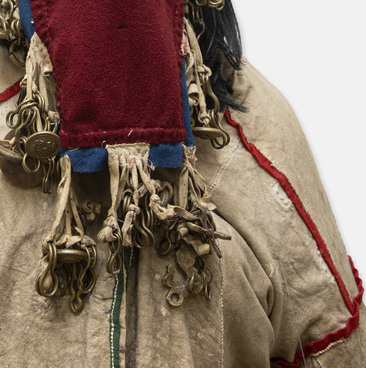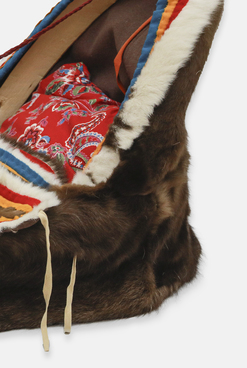A malitsa is a traditional male outerwear of the peoples of the North. There is no front opening on the malitsa. It is sewn with fur inside from the autumn skins of deer. A malitsa resembles a loose knee-length shirt, with the front hem made a little shorter to make walking more convenient.
A malitsa is put on over the head — this form of outerwear is also used for children under five. A hood is usually sewn to the malitsa, which replaces a hat even in the coldest weather. The hood is often equipped with a drawstring along the edge which is used to regulate the fit.
The hood consists of two layers, with fur inside and outside, and dark fur is considered particularly beautiful. The hood is made from the pelt of a newborn calf. Northern people do not kill calves for this purpose but instead use the pelts of animals who have already died. Sometimes, the hood is trimmed with thick white reindeer or beaver fur.
Mittens made of kamus — skin from the lower leg of a deer — are sewn tightly to the sleeves of the malitsa. As a result, it is impossible to lose the mittens, which would be equal to getting frostbite in the cold, especially on the road. At the wrist, above the palm of the hand, there are slits in the sleeves so that the wearer can take the hands out for a short period if necessary.
The hem of the malitsa is trimmed with the autumn skin of a calf or the summer skin of an adult deer — fur of inferior quality with a short pile. One or two strips of colored yellow, red, or green cloth are sewn above it, and sometimes a mosaic of white and dark fur.
The loose cut of the malitsa with wide armholes allows a man to take his arms out of the sleeves without taking off the shirt and complete some small tasks under the clothes such as fixing a piece of equipment or filling a pipe. Since the malitsa is worn with a belt, and the front panels overlap, they form a sort of warm pocket.
A special cloth shirt is worn over the malitsa to protect it from moisture, dirt, and the sun. The cut of this shirt is similar to that of the malitsa: the front and back are sewn from whole pieces of cloth and taper slightly at the bottom. A Nenets man usually has three or four malitsas, sewn by hand by women who learn this craft from early childhood. For sewing, northern craftswomen use strong homespun threads made from reindeer tendons.





